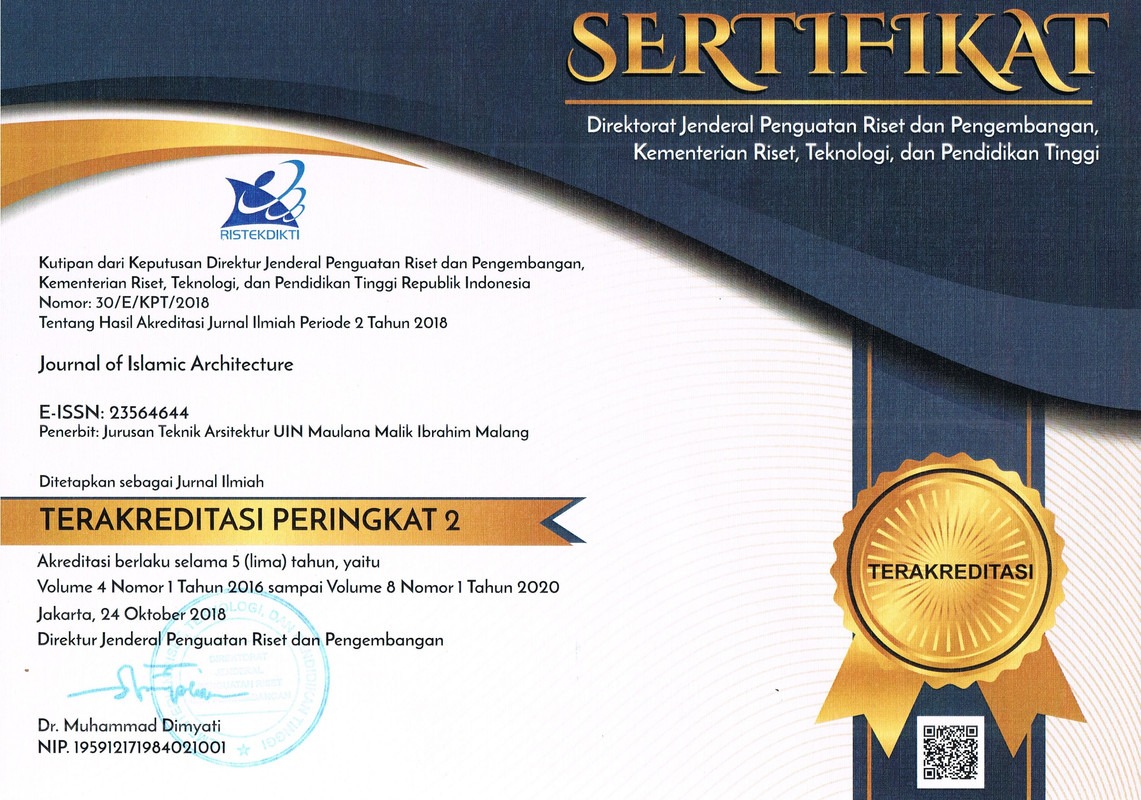IDENTIFYING ISLAMIC VALUES ON GREEN ARCHITECTURAL CONCEPT: QUANTITATIVE APPROACHES TO CONTENT ANALYSIS
Abstract
The paper investigates to explore Islamic religious values which related to environment Maintaining environmental balance is the primary human task. Besides, religious belief is a source of ethics and morality. It is a guidance of truth for making decisions before taking action influencing humans’ behavior towards perceptions and behavior in maintaining and preserving their environment. This study employs a quantitative approach by conducting a content analysis aiming to understand every word (text) related to land, water, and air through the interpretation of the Quran. This research will produce several criteria as the basic concepts for the development of Islamic values-based green architecture.
Keywords
Full Text:
PDFReferences
M. Sani, “Learn Quran,” 2018. [Online]. Available: https://tafsir.learn-quran.co/id/topics.
A. Bagader, A. El-Sabbagh, M. Al-Glayand, and M. Samarrai, “Environmental Protection in Islam (part 1 of 7): A General Introduction,” Islam Religion, 2006. [Online]. Available: http://www.islamreligion.com/articles/307.
R. Z. Harahap, “Etika Islam dalam Mengelola Lingkungan Hidup,” Edu Tech, vol. 1, no. 1, 2015.
A. Aziz, “KONSERVASI ALAM DALAM PERSPEKTIF ETIKA ISLAM; TANTANGAN DAN TUNTUTAN GLOBALISASI,” Akademika, vol. 19, no. 2, pp. 304–321, 2014.
U. G. B. Council, LEED: Leadership in energy and environmental design. Washington: Weltec Engineering and Consultant Ltd., 2011.
O. Johansson, “The spatial diffusion of green building technologies: The case of Leadership in Energy and Environmental Design (LEED) in the United States,” International Journal of Technology Management & Sustainable Development, vol. 10, no. 3, pp. 251–266, 2012.
I. Borowy, Defining Sustainable Development for Our Common Future A History of the World Commission on Environment and Development (Brundtland Commission). London: Routledge, 2013.
M. Romli, “Mewujudkan Pembangunan Berkelanjutan melalui Prinsip-Prinsip Etika dan Moral Islam Ringkasan.” Institut Pertanian Bogor, Bogor, 2016.
W. Jenkins and C. K. Chapple, “Religion and Environment,” Annual Review of Environment and Resources, vol. 36, pp. 441–463, 2011.
M. N. Mamat, S. F. Mahamood, and I. Ismail, “Islamic Philosophy on Behaviour - Based Environmental Attitude,” Procedia - Social and Behavioral Sciences, vol. 49, pp. 85–92, 2012.
M. H. Efendi, M. H. Irawati, F. Rochman, and A. Gofur, “Environmental Conservation Education by Applying Islamic Values,” Journal of Education & Social Policy, vol. 4, no. 2, pp. 180–186, 2017.
Green Building Council Indonesia, Greenship Rating Tools. Jakarta: GREEN BUILDING COUNCIL INDONESIA, 2013.
Safrilsyah dan Fitriani, “Agama Dan Kesadaran Menjaga Lingkungan Hidup,” Subtantia, vol. 16, no. April, pp. 61–78, 2014.
M. M. Dj, “Kerusakan Lingkungan Perspektif Al-Qur’an (Studi Tentang Pemanasan Global),” Universitas Islam Negeri Syarif Hidayatullah Jakarta, 2010.
I. Sarkar, “Islamic Values And Environmental Disquiet,” Philosophy and Progress, vol. LVII–LVIII, 2015.
F. Khalid, “The Environment in Islam,” The Environment In Islam, no. September, p. 17, 2010.
M. Nafisah, “Al-Quran dan Konservasi Lingkungan (Suatu Pendekatan Maqâsid al- Syarî ’ah),” UIN Syarif Hidayatullah Jakarta, 2017.
T. Maisaroh, “Akhlak Terhadap Lingkungan hidup Dalam Al-Quran (Studi Tafsir Al-Mishbah),” UIN Raden Intan Lampung, 2017.
O. M. Ashtankar, “Islamic perspectives on environmental protection,” International Journal of Applied Research, vol. 2, no. 1, pp. 438–441, 2016.
Ustadz Abu Abdillah Syahrul Fatwa bin Lukman, “Melestarikan Lingkungan Hidup,” 1435 H_2014 M, no. 143.
DOI: https://doi.org/10.18860/jia.v5i4.7568
Refbacks
- There are currently no refbacks.






